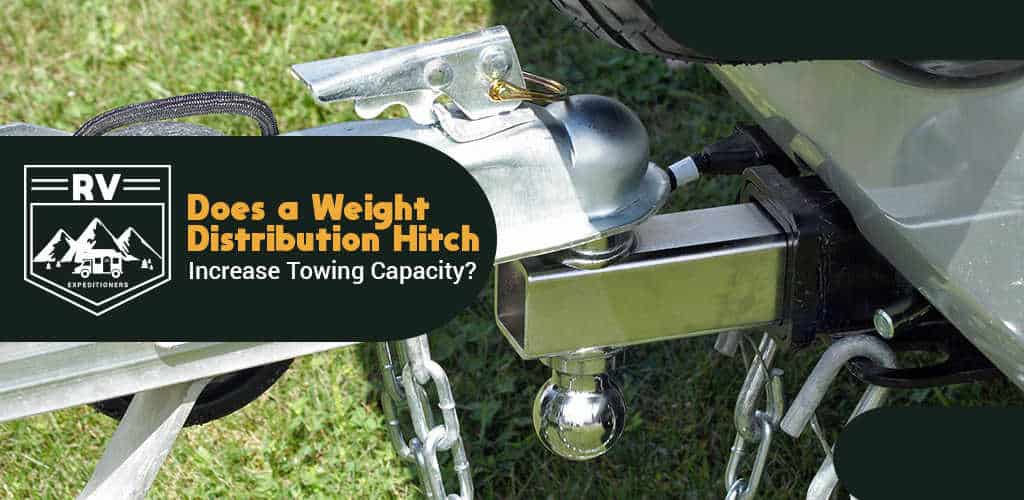A weight distribution hitch (WDH) is a great thing to have, whether you’re towing a small or extra-large trailer. It helps with the vertical alignment of both the tow vehicle and the trailer. A WDH with sway control can further improve handling. But, does a weight distribution hitch increase towing capacity?
While it has many benefits, a weight distribution hitch doesn’t exactly increase the towing capacity. Keep reading for more on how weight distribution hitches work, why they’re better than weight carrying hitches, and whether you should get one.
Recommended Read: The Best Weight Distribution Hitches Reviewed
Main Weight Measurements to Know
When towing a trailer, there are several weight measurements that you should be aware of, though the most important weights are the gross trailer weight (GTW) and tongue weight.
The gross trailer weight is the total weight of your trailer. You should measure the trailer at a public scale when it’s packed with everything you need for the trip. Use that weight when choosing a weight distribution system.
The tongue weight is the weight of the trailer’s tongue. It represents the force exerted by the tongue on the towing hitch. The ideal tongue weight is 9-15% of the trailer’s gross weight. In case it exceeds 15%, move some of the cargo to the back of the trailer. If the tongue is too light, just load the front of the trailer.
Other Important Weight Measurements
The other weights are that of the tow vehicle, the disconnected trailer, the combination of the two, the tow vehicle and trailer’s axles, and the towing capacity.
Under no circumstances should the weight of the trailer exceed the maximum towing capacity of the tow vehicle. Also, the combined weight of the two must never exceed the limit specified by the tow vehicle’s manufacturer.
Benefits of a Weight Distribution Hitch
A weight distribution hitch can help regardless of the trailer. However, if your trailer weighs over 5,000 lbs., you’d have to have it installed. But if you have a heavy-duty truck, this threshold can go up to between 6,000 and 8,500 lbs.
You should also use a weight distribution hitch if the GTW exceeds 50% of the tow vehicle’s towing capacity or if you have significant problems with swaying. If you have problems with vertical alignment (sinking hitch or higher than it should be) and steering, you should use a weight distribution hitch.
Here are some of the major benefits of a weight distribution hitch. (Full list and explanation on the article linked)
Even weight distribution
The main task of a weight distribution hitch is to transfer weight from the hitch to the tow vehicle and trailer’s axles. The aim here is to prevent the hitch from sinking to the ground.
Reduced swaying
Weight distribution hitches often come with some sort of sway control. Depending on the type, sway control reduces the sway of the trailer, which improves handling.
Improved stability and control
Towing vehicles with weight distribution hitches have far less handling problems than the ones with weight carry hitches.
Safer steering and braking
With the proper vertical and horizontal alignment, you will be able to steer more easily and brake more efficiently. You won’t have to wrestle with the steering wheel as much.
Less wear
Thanks to the optimal alignment and stability, you won’t put as much wear on your tow vehicle and trailer.
But, a weight distribution hitch doesn’t increase towing capacity? Your vehicle’s factory towing capacity remains and can’t be changed without modifying the car. A weight distribution hitch isn’t designed to increase towing capacity.
How It Works
Though it does take time to install and adjust, a weight distribution hitch is actually a simple contraption. Once installed, it redistributes some of the weight towards the axles of your tow vehicle and trailer. This way, it levels both the tow vehicle and the trailer.
However, not every weight distribution hitch works with every tow vehicle and trailer. You should pick one based on the trailer and tongue’s weight. If you pick a hitch with insufficient weight capacity, it might break off as you drive. On the other hand, a hitch that has an overly high weight capacity makes for an uncomfortable ride.
The majority of weight distribution hitches come with some sort of sway control. There are four main types – friction bars, dual-cam stabilizers, two-point sway control, and four-point sway control.
Friction bars are the simplest and most affordable option but offer relatively mild sway correction. You should only use them with lightweight trailers. Dual-cam stabilizers, while giving better support, should also be used with lightweight trailers. However, you can use them with heavy flatbed trailers.
Two-point sway controls are for medium to large trailers. If you have an extra-large trailer, you might want to opt for a weight distribution hitch that’s equipped with four-point sway control.
Weight Carrying vs. Weight Distribution
Weight-carrying hitches, as the name suggests, carry the weight of the trailer. While you can use them regardless of your trailer’s weight, experts don’t recommend them for heavy loads, as the trailer tongue might sink.
On the other hand, weight distribution hitches distribute weight towards the axles and lift some of the burden off the hitch.
Final Thoughts
While it can’t increase your vehicle’s towing capacity, a weight distribution hitch can give you a safer, smoother, and more stable ride. It will regulate the height of the trailer tongue by distributing some weight toward the axles. Sway control, if installed, will also mitigate the trailer’s side-to-side movement.

